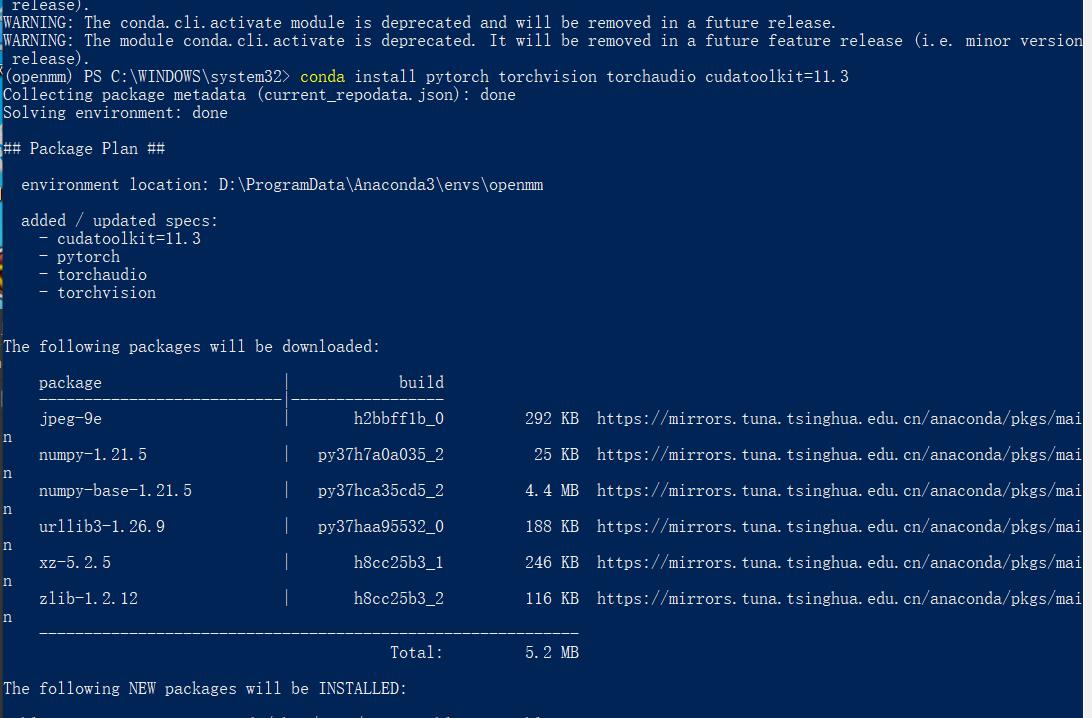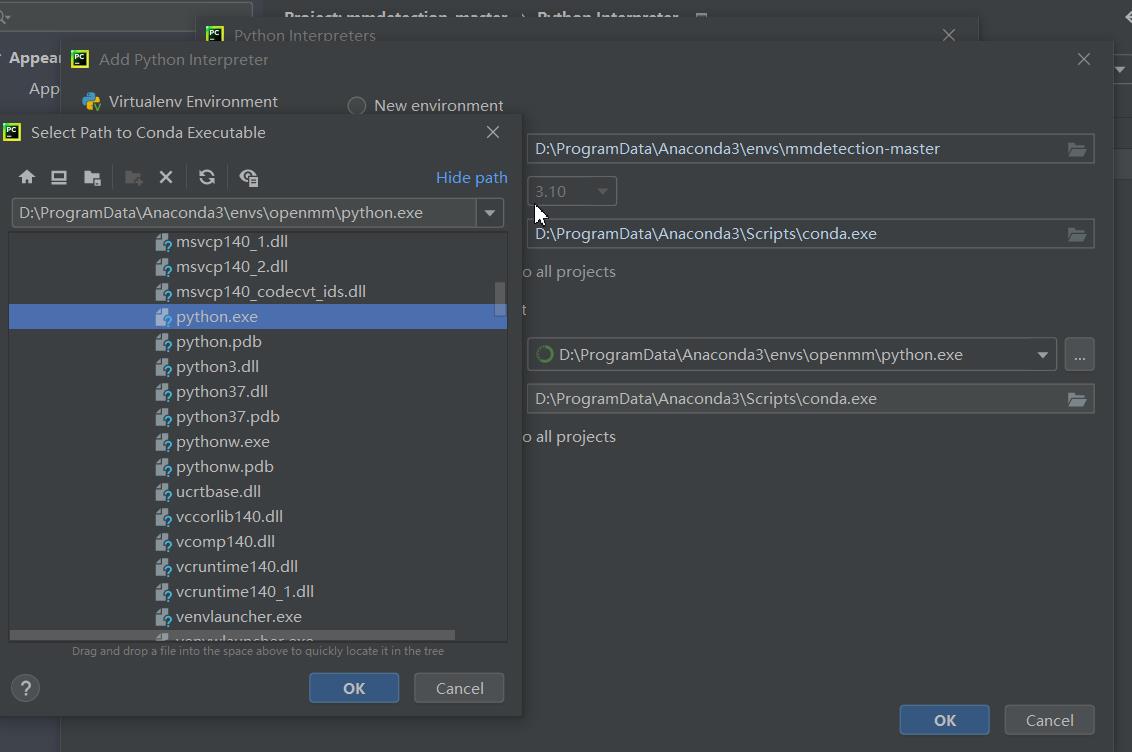MMDetection实战:MMDetection训练与测试
Posted AI浩
tags:
篇首语:本文由小常识网(cha138.com)小编为大家整理,主要介绍了MMDetection实战:MMDetection训练与测试相关的知识,希望对你有一定的参考价值。
摘要
MMDetection是商汤和港中文大学针对目标检测任务推出的一个开源项目,它基于Pytorch实现了大量的目标检测算法,把数据集构建、模型搭建、训练策略等过程都封装成了一个个模块,通过模块调用的方式,我们能够以很少的代码量实现一个新算法,大大提高了代码复用率。
GitHub链接:https://github.com/open-mmlab/mmdetection。
Gitee链接:https://gitee.com/open-mmlab/mmdetection。
主分支代码目前支持 PyTorch 1.5 以上的版本。主要特性:
-
模块化设计
MMDetection 将检测框架解耦成不同的模块组件,通过组合不同的模块组件,用户可以便捷地构建自定义的检测模型
-
丰富的即插即用的算法和模型
MMDetection 支持了众多主流的和最新的检测算法,例如 Faster R-CNN,Mask R-CNN,RetinaNet 等。
-
速度快
基本的框和 mask 操作都实现了 GPU 版本,训练速度比其他代码库更快或者相当,包括 Detectron2, maskrcnn-benchmark 和 SimpleDet。
-
性能高
MMDetection 这个算法库源自于 COCO 2018 目标检测竞赛的冠军团队 MMDet 团队开发的代码,之后持续进行了改进和提升。
配置文件参数详解
faster_rcnn_r50_fpn_1x_coco.py文件为例,这个文件包含四个文件,分别是:faster_rcnn_r50_fpn.py、coco_detection.py、schedule_1x.py、default_runtime.py。
configs/_base_/schedules/schedule_1x.py
optimizer = dict(type='SGD', lr=0.02, momentum=0.9, weight_decay=0.0001)# 设置优化器类型
optimizer_config = dict(grad_clip=None) # 梯度裁剪配置
#optimizer_config = dict(
# _delete_=True, grad_clip=dict(max_norm=35, norm_type=2))
# lr 参数
lr_config = dict(
policy='step', # lr decay的方式,其余的还有consine cyclic
warmup='linear', # 初始的学习率增加的策略为线性增加
warmup_iters=500, # warmup迭代500次
warmup_ratio=0.001, # warmup的初始学习比率。
step=[8, 11]) # 在8-11个epoch后开始进行lr decay
runner = dict(type='EpochBasedRunner', max_epochs=12) # runner配置,默认epoch为12
faster_rcnn_r50_fpn.py
# model settings
model = dict(
type='FasterRCNN',#model类型
backbone=dict(
type='ResNet',#backone类型
depth=50,#网络层数
num_stages=4,# resnet的stage数量
out_indices=(0, 1, 2, 3), # 输出的stage的序号
frozen_stages=1,# 冻结的stage数量,即该stage不更新参数,-1表示所有的stage都更新参数
norm_cfg=dict(type='BN', requires_grad=True),#表示所采用的归一化算子,一般是 BN 或者 GN。requires_grad 表示该算子是否需要梯度,也就是是否进行参数更新
norm_eval=True,#控制整个骨架网络的归一化算子是否需要变成 eval 模式
style='pytorch',# 网络风格:如果设置pytorch,则stride为2的层是conv3x3的卷积层;如果设置caffe,则stride为2的层是第一个conv1x1的卷积层
init_cfg=dict(type='Pretrained', checkpoint='torchvision://resnet50')),# 表明backbone使用预训练参数,标注其位置
neck=dict(
type='FPN',# FPN特征融合neck
in_channels=[256, 512, 1024, 2048],# FPN接受的channels,和backnone resnet的stage2-5的输出channels对应
out_channels=256,# feature pyramid每一层的输出channel数
num_outs=5),# 输出的feature pyramid特征层数
rpn_head=dict(
type='RPNHead',# RPN网络类型
in_channels=256,# RPN网络的输入通道数
feat_channels=256,# 特征层的通道数
anchor_generator=dict(
type='AnchorGenerator',
scales=[8],# 生成的anchor的baselen,baselen = sqrt(w*h),w和h为anchor的宽和高
ratios=[0.5, 1.0, 2.0],# anchor的宽高比
strides=[4, 8, 16, 32, 64]),# 在每个特征层上的anchor的步长(对应于原图)
bbox_coder=dict(
type='DeltaXYWHBBoxCoder',
target_means=[.0, .0, .0, .0],# 均值
target_stds=[1.0, 1.0, 1.0, 1.0]),# 均值
loss_cls=dict(
type='CrossEntropyLoss', use_sigmoid=True, loss_weight=1.0),
loss_bbox=dict(type='L1Loss', loss_weight=1.0)),
roi_head=dict(
type='StandardRoIHead',
bbox_roi_extractor=dict(
type='SingleRoIExtractor',
roi_layer=dict(type='RoIAlign', output_size=7, sampling_ratio=0),
out_channels=256,
featmap_strides=[4, 8, 16, 32]),
bbox_head=dict(
type='Shared2FCBBoxHead',# 对应head类
in_channels=256,# head接受的是feature pyramid的输出,in_channels表示进入head时的通道数是256
fc_out_channels=1024,
roi_feat_size=7,
num_classes=80,# 使用coco数据集,所以是80类
bbox_coder=dict(
type='DeltaXYWHBBoxCoder',
target_means=[0., 0., 0., 0.],
target_stds=[0.1, 0.1, 0.2, 0.2]),
reg_class_agnostic=False,
loss_cls=dict(
type='CrossEntropyLoss', use_sigmoid=False, loss_weight=1.0),
loss_bbox=dict(type='L1Loss', loss_weight=1.0))),
# model training and testing settings
train_cfg=dict(
rpn=dict(
assigner=dict(
type='MaxIoUAssigner',# RPN网络的正负样本划分
pos_iou_thr=0.7,# RPN网络的正负样本划分
neg_iou_thr=0.3,# 负样本的iou阈值
min_pos_iou=0.3,# 正样本的iou最小值。如果assign给ground truth的anchors中最大的IOU低于0.3,则忽略所有的anchors,否则保留最大IOU的anchor
match_low_quality=True,
ignore_iof_thr=-1),# 忽略bbox的阈值,当ground truth中包含需要忽略的bbox时使用,-1表示不忽略
sampler=dict(
type='RandomSampler',# 正负样本提取器类型
num=256,# 需提取的正负样本数量
pos_fraction=0.5,# 正样本比例
neg_pos_ub=-1,# 最大负样本比例,大于该比例的负样本忽略,-1表示不忽略
add_gt_as_proposals=False),# 把ground truth加入proposal作为正样本
allowed_border=-1,# 允许在bbox周围外扩一定的像素
pos_weight=-1,# 正样本权重,-1表示不改变原始的权重
debug=False),# debug模式
rpn_proposal=dict(
nms_pre=2000,
max_per_img=1000,
nms=dict(type='nms', iou_threshold=0.7),# nms阈值
min_bbox_size=0),
rcnn=dict(
assigner=dict(
type='MaxIoUAssigner',# RCNN网络正负样本划分
pos_iou_thr=0.5,# 正样本的iou阈值
neg_iou_thr=0.5,# 负样本的iou阈值
min_pos_iou=0.5,# 正样本的iou最小值。如果assign给ground truth的anchors中最大的IOU低于0.3,则忽略所有的anchors,否则保留最大IOU的anchor
match_low_quality=False,
ignore_iof_thr=-1),# 忽略bbox的阈值,当ground truth中包含需要忽略的bbox时使用,-1表示不忽略
sampler=dict(
type='RandomSampler',# 正负样本提取器类型
num=512,# 需提取的正负样本数量
pos_fraction=0.25,# 正样本比例
neg_pos_ub=-1,# 最大负样本比例,大于该比例的负样本忽略,-1表示不忽略
add_gt_as_proposals=True),# 把ground truth加入proposal作为正样本
pos_weight=-1,# 正样本权重,-1表示不改变原始的权重
debug=False)),
test_cfg=dict(
rpn=dict(
nms_pre=1000,# 在nms之前保留的的得分最高的proposal数量
max_per_img=1000,
nms=dict(type='nms', iou_threshold=0.7),
min_bbox_size=0), # 最小bbox尺寸
rcnn=dict(
score_thr=0.05,
nms=dict(type='nms', iou_threshold=0.5),# nms阈值
max_per_img=100)
# soft-nms is also supported for rcnn testing
# e.g., nms=dict(type='soft_nms', iou_threshold=0.5, min_score=0.05)
))
环境准备
CUDA:11.3
新建虚拟环境openmm
conda create --name openmm python=3.7
然后,激活环境。
Win10执行命令:
activate openmm
UBuntu执行命令:
source activate openmm
进入虚拟环境后,安装pytorch,输入命令:
conda install pytorch torchvision torchaudio cudatoolkit=11.3

安装mmcv,执行命令:
pip install mmcv-full
安装mmcv-full,等待的时间较长。如果不报错误,耐心等待即可。

安装完成后,下载mmdetection, 地址链接:https://gitee.com/open-mmlab/mmdetection。
下载完成后,解压,然后pycharm打开。
添加刚才新建的虚拟环境。


在Terminal中激活openmm虚拟环境,防止虚拟环境没有切换过来。

然后,安装mmdet,在Terminal中执行命令:
python setup.py install
在安装mmdet的过程中,会自动下载所需要的安装包。如果存在不能下载的情况,需要单独安装。直到出现下图即可。

验证环境
在工程的根目录新建checkpoints文件夹,下载预训练权重文件,链接:
http://download.openmmlab.com/mmdetection/v2.0/faster_rcnn/faster_rcnn_r50_fpn_1x_coco/faster_rcnn_r50_fpn_1x_coco_20200130-047c8118.pth
下载完成后,将其放入到checkpoints文件夹
新建demo.py文件,插入代码:
from mmdet.apis import init_detector, inference_detector
config_file = 'configs/faster_rcnn/faster_rcnn_r50_fpn_1x_coco.py'
# 从 model zoo 下载 checkpoint 并放在 `checkpoints/` 文件下
# 网址为: http://download.openmmlab.com/mmdetection/v2.0/faster_rcnn/faster_rcnn_r50_fpn_1x_coco/faster_rcnn_r50_fpn_1x_coco_20200130-047c8118.pth
checkpoint_file = 'checkpoints/faster_rcnn_r50_fpn_1x_coco_20200130-047c8118.pth'
device = 'cuda:0'
img='demo/demo.jpg'
# 初始化检测器
model = init_detector(config_file, checkpoint_file, device=device)
# 推理演示图像
result=inference_detector(model, img)
model.show_result(img, result, out_file='result.jpg')
运行代码:

看到这张图说明环境没有问题。
接下来,使用这个环境训练自定义数据集。
训练
制作数据集
Labelme标注的数据集地址链接:
https://download.csdn.net/download/hhhhhhhhhhwwwwwwwwww/63242994?spm=1001.2014.3001.5503
有32个类别,分别是:‘c17’, ‘c5’, ‘helicopter’, ‘c130’, ‘f16’, ‘b2’, ‘other’, ‘b52’, ‘kc10’, ‘command’, ‘f15’, ‘kc135’, ‘a10’, ‘b1’, ‘aew’, ‘f22’, ‘p3’, ‘p8’, ‘f35’, ‘f18’, ‘v22’, ‘f4’, ‘globalhawk’, ‘u2’, ‘su-27’, ‘il-38’, ‘tu-134’, ‘su-33’, ‘an-70’, ‘su-24’, ‘tu-22’, ‘il-76’。
先将其转为COCO数据集,转换代码如下:
# -*- coding:utf-8 -*-
# !/usr/bin/env python
import json
import os
import shutil
from labelme import utils
import numpy as np
import glob
import PIL.Image
labels='c17':0,'c5':1,'helicopter':2,'c130':3,'f16':4,
'b2':5,'other':6,'b52':7,'kc10':8,'command':9,'f15':10,
'kc135':11,'a10':12,'b1':13,'aew':14,'f22':15,'p3':16,'p8':17,
'f35':18,'f18':19,'v22':20,'f4':21,'globalhawk':22,'u2':23,'su-27':24,
'il-38':25,'tu-134':26,'su-33':27,'an-70':28,'su-24':29,'tu-22':30,'il-76':31
class MyEncoder(json.JSONEncoder):
def default(self, obj):
if isinstance(obj, np.integer):
return int(obj)
elif isinstance(obj, np.floating):
return float(obj)
elif isinstance(obj, np.ndarray):
return obj.tolist()
else:
return super(MyEncoder, self).default(obj)
class labelme2coco(object):
def __init__(self, labelme_json=[], save_json_path='./tran.json'):
'''
:param labelme_json: 所有labelme的json文件路径组成的列表
:param save_json_path: json保存位置
'''
self.labelme_json = labelme_json
self.save_json_path = save_json_path
self.images = []
self.categories = []
self.annotations = []
# self.data_coco =
self.label = []
self.annID = 1
self.height = 0
self.width = 0
self.save_json()
def data_transfer(self):
for num, json_file in enumerate(self.labelme_json):
imagePath=json_file.split('.')[0]+'.jpg'
imageName=imagePath.split('\\\\')[-1]
# print(imageName)
with open(json_file, 'r') as fp:
data = json.load(fp) # 加载json文件
self.images.append(self.image(data, num,imageName))
for shapes in data['shapes']:
label = shapes['label'].lower()
if label not in self.label:
self.categories.append(self.categorie(label))
self.label.append(label)
points = shapes['points'] # 这里的point是用rectangle标注得到的,只有两个点,需要转成四个点
# points.append([points[0][0],points[1][1]])
# points.append([points[1][0],points[0][1]])
self.annotations.append(self.annotation(points, label, num))
self.annID += 1
def image(self, data, num,imagePath):
image =
img = utils.img_b64_to_arr(data['imageData']) # 解析原图片数据
# img=io.imread(data['imagePath']) # 通过图片路径打开图片
# img = cv2.imread(data['imagePath'], 0)
height, width = img.shape[:2]
img = None
image['height'] = height
image['width'] = width
image['id'] = num + 1
# image['file_name'] = data['imagePath'].split('/')[-1]
image['file_name'] = imagePath
self.height = height
self.width = width
return image
def categorie(self, label):
categorie =
categorie['supercategory'] = 'Cancer'
categorie['id'] = labels[label] # 0 默认为背景
categorie['name'] = label
return categorie
def annotation(self, points, label, num):
annotation =
annotation['segmentation'] = [list(np.asarray(points).flatten())]
annotation['iscrowd'] = 0
annotation['image_id'] = num + 1
# annotation['bbox'] = str(self.getbbox(points)) # 使用list保存json文件时报错(不知道为什么)
# list(map(int,a[1:-1].split(','))) a=annotation['bbox'] 使用该方式转成list
annotation['bbox'] = list(map(float, self.getbbox(points)))
annotation['area'] = annotation['bbox'][2] * annotation['bbox'][3]
# annotation['category_id'] = self.getcatid(label)
annotation['category_id'] = self.getcatid(label) # 注意,源代码默认为1
# print(label,annotation['category_id'])
annotation['id'] = self.annID
return annotation
def getcatid(self, label):
for categorie in self.categories:
if label == categorie['name']:
return categorie['id']
return 1
def getbbox(self, points):
# img = np.zeros([self.height,self.width],np.uint8)
# cv2.polylines(img, [np.asarray(points)], True, 1, lineType=cv2.LINE_AA) # 画边界线
# cv2.fillPoly(img, [np.asarray(points)], 1) # 画多边形 内部像素值为1
polygons = points
mask = self.polygons_to_mask([self.height, self.width], polygons)
return self.mask2box以上是关于MMDetection实战:MMDetection训练与测试的主要内容,如果未能解决你的问题,请参考以下文章
自动驾驶感知算法实战5——MMdetection3d环境搭建使用MMdetection3d做3D目标检测训练自己的数据集测试可视化,以及常见的错误
自动驾驶感知算法实战5——MMdetection3d环境搭建使用MMdetection3d做3D目标检测训练自己的数据集测试可视化,以及常见的错误